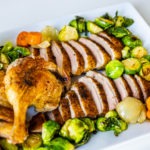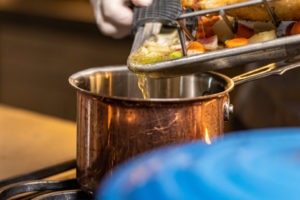Description
An easy way to get perfect skin and perfect meat from a roast duck or goose. Based on the method by Hank Shaw presented at SimplyRecipes.com
Ingredients
Scale
- 1 whole duck or goose, thawed
- 1 lemon
- 1 head of garlic, whole
- Kosher salt and freshly ground pepper
Optional but recommended: Root vegetables to roast with the duck
Instructions
- Preheat the oven to 325°F (163°C).
- Prepare the thawed duck (or goose) by first cutting off the last two joints of the wings. Remove the neck and giblets from the body cavity along with any chunks of fat that may be inside the cavity. Cut off the tail (also called the Pope’s nose).
- Save all those bits and while the duck is roasting, brown all the meaty parts and the tail and make a stock out of them for gravy.
- If there is excess skin, remove it as well. You can render down the fat chunks and skin to get even more fat for later use.
- Prick the skin of the duck all over with a needle, being careful to not pierce the meat.
- Cut the lemon in half and rub the cut face all over the bird, squeezing as you go to bathe the bird in lemon juice.
- Stuff the lemon into the cavity of the bird. Cut the head of garlic in half along its equator and stuff it into the cavity as well.
- Sprinkle the duck thoroughly with kosher salt. Season with pepper, as well.
- Place the duck on a rack in a pan, insert the probe from a ChefAlarm into the thermal center of the poultry’s breast. Set the high-temp alarm for 130°F (54°C). Put the bird in the oven and cook.
- If you are roasting root veggies with the duck, add them to the roasting pan about 20 minutes into the cooking.
- When the high alarm sounds (after roughly 40 minutes), verify the temperatures in the breast using a Thermapen.
- If the breast reads nothing below 130°F (54°C), remove the duck from the oven and cut the breasts out whole. Set them aside, tented with foil.
- Insert the probe from the ChefAlarm into one of the thighs of the duck, reset the high-temp alarm for 175°F (79°C) and put the partially dismantled duck back in the oven.
- Cook until the high alarm sounds again, verify with the Thermapen again, and remove the duck from the oven.
- You should have a decent amount of fat in the bottom of the pan. Pour it into a container for later use. Also pour about a tablespoon of it into the bottom of a sauté pan.
- Heat the pan over medium to medium-high heat while you carve the legs and wings from the duck. (Lower heat will give you more time to render the fat from the skin before browning it too far. This is especially important for the breasts.)
- Place the legs and wings skin-side-down in the pan and cook until the skin is browned and crisp.
- Remove the legs and wings from the pan and add the breasts, also skin side down, and cook until the skin is very well rendered and crisp. Check the breasts as you cook with a Thermapen, you don’t want them to go over 135°F (57°C).
- Slice the breasts and arrange the whole lot on a platter for serving, along with the roasted vegetables from the pan.
- Enjoy!

